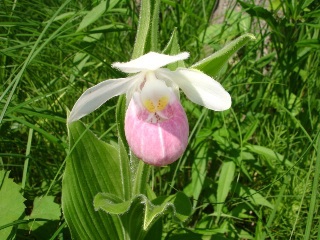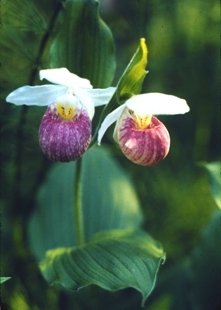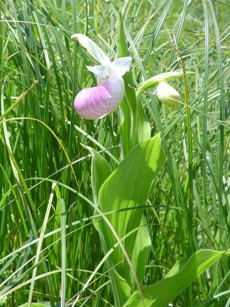Showy Lady Slippers
Michigan Department of Natural Resources sent this bulletin at 07/03/2013 04:14 PM EDTWildlife Viewing
Michigan wildlife viewers and enthusiasts,
Following is another in our series of stories about Michigan’s unique and wonderful wildlife species. Enjoy!
Showy Lady Slippers
by Doug Reeves, assistant chief, DNR Wildlife Division
 As I was motoring down M-28 headed for Marquette one early morning during the first few days of July, I noticed a clump of flowers right at the edge of the woods along a ditch. I could only think of one plant that would look like that during early summer, and I had not noticed them in the area before. I was alone on the road, so I made a U-turn and went back for a closer look. Wow, what beauty! My through-the-windshield identification had been correct. They were showy lady slippers, and in the early morning sun, they seemed almost unreal.
As I was motoring down M-28 headed for Marquette one early morning during the first few days of July, I noticed a clump of flowers right at the edge of the woods along a ditch. I could only think of one plant that would look like that during early summer, and I had not noticed them in the area before. I was alone on the road, so I made a U-turn and went back for a closer look. Wow, what beauty! My through-the-windshield identification had been correct. They were showy lady slippers, and in the early morning sun, they seemed almost unreal.
I can almost count on the fingers of one hand the locations that I know about where showy lady slippers occur in Michigan, although literature reports indicate they are more widely distributed than I would have expected. One of the patches I observed for several years has slowly faded away, but it used to contain over 100 flowering heads annually. I believe closure of the canopy in the cedar-spruce-tamarack forest finally shaded them out.
Showy lady slippers are orchids, in this case among the group that is commonly called moccasin flowers. Not to be confused with showy orchis, a plant that typically does not exceed 8 inches in height and that grows in hardwood forests, showy lady slippers bloom on stems that are often around 20 inches tall. The flowers are large for moccasin flowers, pink on the bottom with sepals (frequently referred to as petals) that are usually white. While photographing some of the flowers in one patch many years ago, I discovered the older flowers were chock full of dead skipper butterflies – an interesting observation, and I never understood why that situation might have happened. There is probably a theory to explain it among the literature somewhere, because I am sure I am not the first person to have noticed such an occurrence, but I have never come across a logical argument for it.
 Don’t expect to keep your feet dry if you approach blooming showy lady slipper flowers. The places where I have found them are all wet, in fact springy, with the water oozing up from beneath the surface, as it does in fens. Their habitats are good places to get mosquito-bitten most any time of the day when the plants are in bloom. My observations match well with the description of typical habitat that Fred Case, Jr. described in his book, “Orchids of the Western Great Lakes Region,” where he described the showy lady slipper as, “Essentially a moisture loving plant, it chooses the wettest open situations available.”
Don’t expect to keep your feet dry if you approach blooming showy lady slipper flowers. The places where I have found them are all wet, in fact springy, with the water oozing up from beneath the surface, as it does in fens. Their habitats are good places to get mosquito-bitten most any time of the day when the plants are in bloom. My observations match well with the description of typical habitat that Fred Case, Jr. described in his book, “Orchids of the Western Great Lakes Region,” where he described the showy lady slipper as, “Essentially a moisture loving plant, it chooses the wettest open situations available.”
In reading Mr. Case’s account of the showy lady slipper, I was fascinated to find information that he attributed to a “late professor Warren Waterman,” who reported that showy lady slipper seed germination only takes place at a soil depth of 1-2 inches. The account continues, “Waterman concluded that the deer, milling around in their winter yards, planted the seeds inadvertently.” Now there’s a connection I never would have made! Yet, it certainly seems like a real possibility in the places where I have seen the plants growing. In fact, the plants I observed along M-28 were in a well-known deer yard. I got to know Mr. Case in his later years, and one of the things he told me was that deer eat orchid flowers because they produce a very small amount of vanillin (yes, the same as vanilla flavoring) that deer can smell and that attracts them. Yet, deer have mostly left the swamps and are on “summer range” when showy lady slippers flower, so they would not be in those places (at least not in large numbers) to eat the flowers when the plants are in bloom. That whole system is something to ponder.
By the way, Mr. Case’s account of the showy lady slipper ends with a warning: “the hairy leaves and stems of the showy lady’s slipper are extremely poisonous to some people producing in them a reaction similar to that caused by poison ivy.” I am glad I have never touched one of the plants, because I react unpleasantly to poison ivy. Then again, since it is illegal to pick those flowers on state land and the plants I know about are all in state forests, I have never had reason to touch them. My advice is to observe and enjoy, even photograph if you can do it without harming the plants, but then leave them unmolested.
You just never know what you are going to encounter in the wildlands of Michigan or where your mind will take you after the encounter. One thing is certain though – you’ve got to get outdoors to experience these wonders!
 How can you help wildlife and their habitats in Michigan?
How can you help wildlife and their habitats in Michigan?
There are several easy ways you can help conserve Michigan's wildlife and their habitats:
- Buy a wildlife habitat license plate.
- Buy a Living Resources wildlife patch.
- Simply make a tax-deductible donation.
-
Learn about creating wildlife habitat on your property.
With increased funding to the Nongame Wildlife Fund, we can boost our efforts to conserve and manage Michigan’s wildlife. Join us in protecting the natural, wild and wonderful things that make MiNature.

